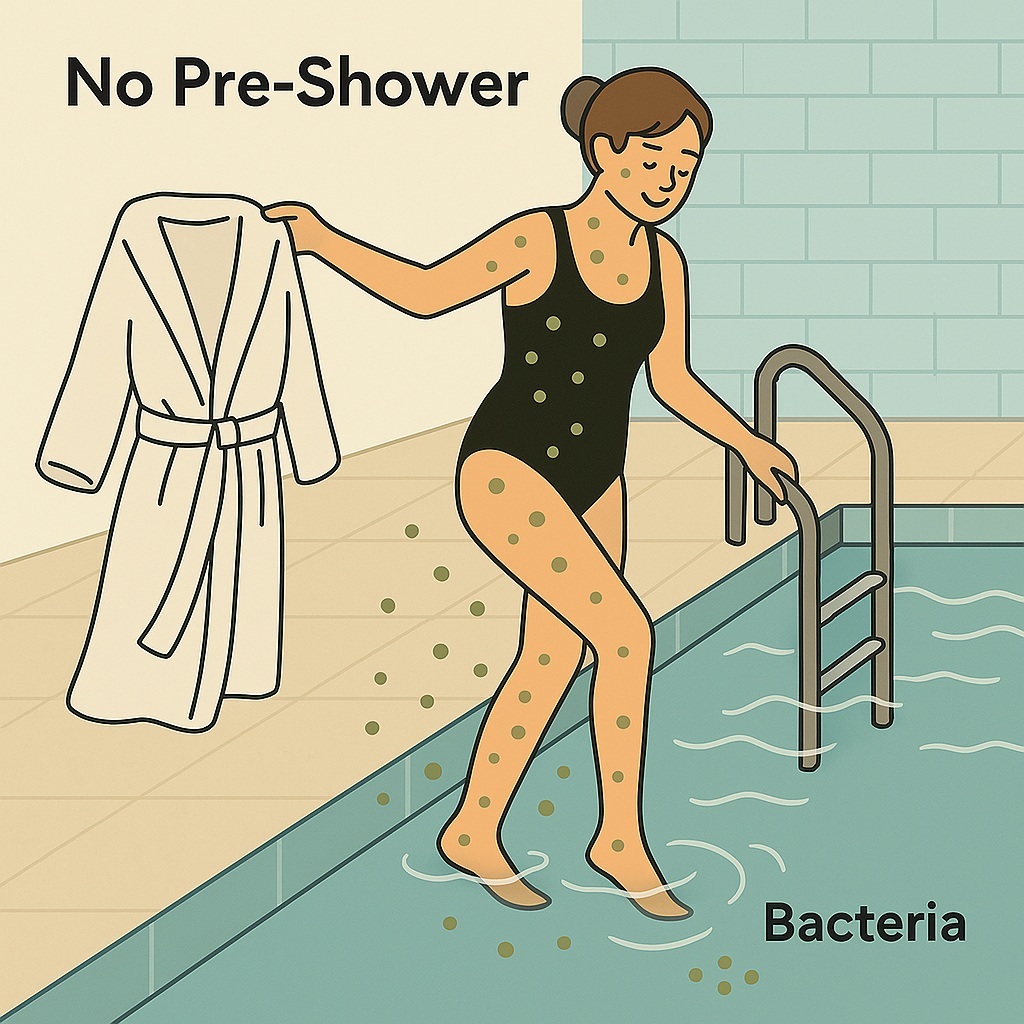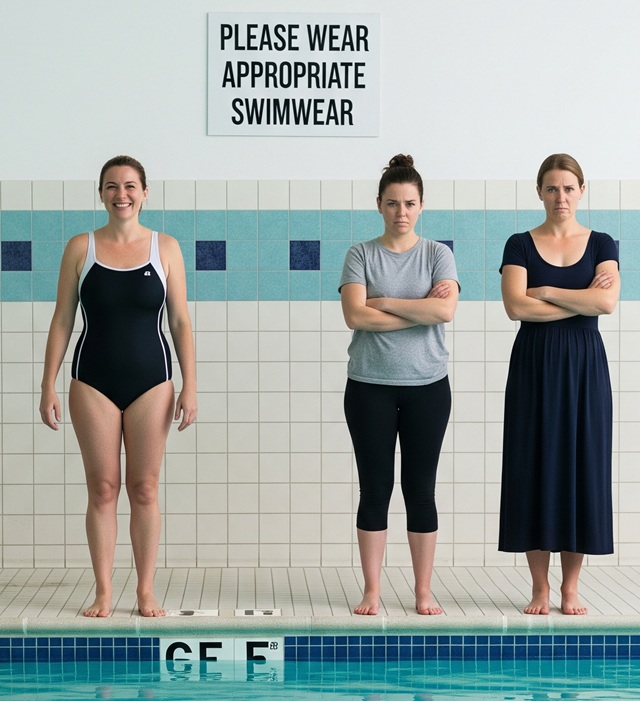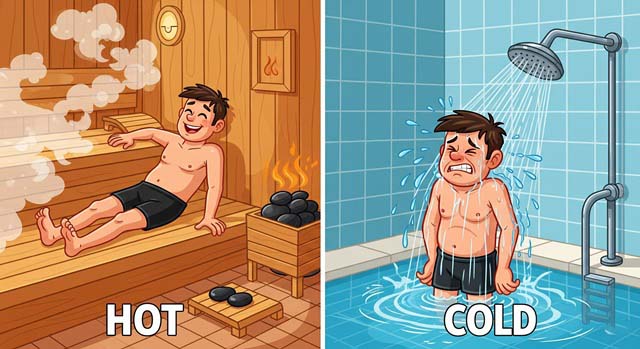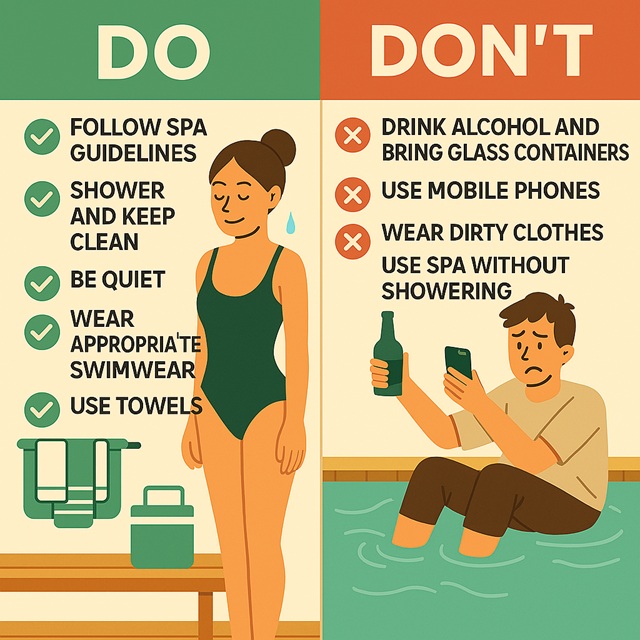Experiencing a luxury spa in the UK and London offers unparalleled relaxation and rejuvenation in different settings, be it in a luxury hotel or country club.
With London having the highest concentration of wellness spas in the UK, offering everything from boutique day spas to high-end hotel wellness centres, the city contributes significantly to the UK’s spa market, which reached £7.9 billion in revenue in 2024–25.
As the number of spas increases, so does the need to ensure that hygiene and health requirements are met for the most positive spa experience.
Spa visitors may miss, forget or simply ignore the guidance provided in spas and consequently not follow it, which may lead to hygiene and health concerns, impacting the spa visit for everyone negatively.
So, we’ve put together this hands-on guide to spa etiquette covering hygiene, behaviour, clothing, and health considerations for anyone intending to visit a spa – PLEASE follow these suggestions when visiting a spa, as everyone will thank you for it. And act as a role model so that future generations follow suit.
Spa Etiquette Hygiene Essentials
When you enter a spa, you usually go through the changing rooms where you find showers and toilets. There’s a good reason for that – it’s to ensure you’re clean before entering!

- Always Shower First: Shower before entering shared facilities like pools, saunas, and steam rooms. And this means showering once is not enough! You should shower every time you sweat, for example, before entering a pool again. So, after using the sauna or steam room, take a cold shower first, please!
- Spa Towels: Use the towels provided by the spa; sit on them in the sauna or steam rooms as well as on loungers. They’re not there to reserve loungers, though!
- Footwear: Wear spa-provided slippers or flip-flops around wet areas to maintain hygiene.
Spa Behaviour Considerations

A spa is understood to be a calm and intimate sanctuary where people rejuvenate. Loud conversations, phone noises, video recordings and other noisy or disruptive activities should be avoided, and most spas will not allow photography and filming.
- Respect Silence: Keep conversations quiet and minimal to maintain tranquillity.
- Mobile Devices: Turn off or silence your mobile phones to respect others’ relaxation.
- Privacy: Respect personal space, privacy and avoid unnecessary eye contact or conversation.
Appropriate Clothing in Spas

As spa users tend to swim, it’s advisable not to wear normal clothing that’s not suitable for water activities. Some spa users may want to cover their bodies, which is acceptable if they use suitable full-body swimsuits, for example.
- Swimwear: Use appropriate swimwear in pools, hot tubs, and thermal facilities.
- Robes: Wear provided robes and slippers when moving between spa areas.
- Jewellery and Valuables: Avoid wearing excessive jewellery or carrying valuables into spa areas.
Spa Health Considerations

- Balance exposure to hot and cold: It’s advisable to keep a healthy balance of using the sauna, steam or jacuzzi and a cold plunge or cold shower. This supports the body’s recovery in between those sessions. So, after you’ve used the sauna for the recommended 10 minutes, you’d take a cold shower and then cool your body down further in a cold plunge or by lying down on a lounger outside in cooler air.
- Hydrate: Drink plenty of water before, during, and after spa use to remain hydrated.
- Limit Time: Do not exceed recommended times in hot facilities (saunas, steam rooms, hot tubs).
- Health Conditions: Inform spa staff of any medical conditions or allergies before treatments.
Wellness Tips for Enhanced Spa Experiences
- Mindfulness: Practice deep breathing or meditation during your spa session – most spas offer relaxation areas or rooms.
- Balanced Diet: Eat lightly before and during your visit to avoid discomfort. Using a spa is about cleansing, so the food and beverages you consume should support this. Many spas will offer tap water, herbal teas and fresh fruit. Coconut water and fresh juices can also support the cleansing process.
- Post-Spa Relaxation: Allow yourself quiet downtime post-treatment to prolong relaxation benefits.
- Digital Detox: Relaxation, especially of the mind and eyes, can only happen without digital devices during spa sessions. Whenever you take a time out in a spa, replace reading a book or magazine digitally with a paper format to avoid eyestrain and other digital distractions. A digital detox is especially beneficial if you work mostly online.
Spa Etiquette Dos & Don’ts
- Do: Arrive on time for treatments and sessions, and shower beforehand.
- Do: Follow instructions provided by spa professionals and spa signs.
- Do: Respect the spa’s guidelines, clearly displayed at all times.

- Don’t: Use spa facilities if unwell, contagious, or with skin conditions.
- Don’t: Bring glass containers into spa areas and consume alcoholic beverages.
- Don’t: Shave or perform personal grooming in shared spa facilities.
Evolution of Spa Health & Safety Regulations in the UK
1974:
The Health and Safety at Work Act laid the foundation for workplace safety, including spas. It mandates employers to protect staff and visitors from health risks.
1999:
The Management of Health and Safety at Work Regulations introduced formal risk assessments and procedures for imminent danger.
2002:
The Control of Substances Hazardous to Health (COSHH) regulations addressed chemical and biological risks—critical for spa environments using disinfectants and treatments.
2006:
The HSE and Health Protection Agency published Management of Spa Pools: Controlling the Risks of Infection, highlighting risks like Legionella and Pseudomonas.
2017:
The updated HSG282 guidance focused on controlling Legionella and other infectious agents in spa-pool systems. It emphasized water quality testing, maintenance, and design standards.
Current Hygiene & Safety Standards for UK Spas (2025)
Daily cleaning protocols:
Pools, saunas, and treatment rooms must be disinfected regularly. Steam rooms require air refresh rates of 6x/hour; saunas 7–10x/hour.
Tool sterilisation:
Use of autoclaves, alcohol wipes, and high-temp laundering for towels and porous items.
Water testing:
Regular microbiological testing for Legionella, E. coli, and Pseudomonas is required. Spa pools must meet strict water clarity and pH standards.
PPE requirements:
Staff must use nitrile gloves, face masks, and aprons during treatments and cleaning.
Waste disposal:
Clinical waste (e.g. from treatments) must be disposed of in yellow bags and sharps bins.
Recent Updates & Trends
Mental health inclusion:
As of 2025, HSE guidance encourages spas to include mental well-being in risk assessments—especially for staff in high-pressure roles.
Climate-related safety:
New best practices suggest assessing risks from heat exposure and air quality, especially in hydrothermal areas.
Digital compliance tools:
Spa operators are adopting software for real-time hygiene tracking and automated reporting.
Scotland’s regulatory shift:
A public consultation in 2024 may lead to stricter licensing for non-surgical treatments, potentially influencing UK-wide standards.
Author Profile

- Online Media & PR Strategist
- As the Chief of Marketing at the digital marketing agency ClickDo Ltd I blog regularly about technology, education, lifestyle, business and many more topics.
Latest entries
 Living in LondonNovember 2, 20259 Cheapest Areas to Rent in London
Living in LondonNovember 2, 20259 Cheapest Areas to Rent in London Health & BeautyOctober 16, 202513 Best Gyms in London to Keep Fit and Healthy
Health & BeautyOctober 16, 202513 Best Gyms in London to Keep Fit and Healthy EmploymentSeptember 25, 2025How to Make Money in London (9 Best Ways to Earn Extra Cash)
EmploymentSeptember 25, 2025How to Make Money in London (9 Best Ways to Earn Extra Cash) Business AdviceSeptember 15, 2025Why Authentic Collaborations are the Future of Brand Marketing
Business AdviceSeptember 15, 2025Why Authentic Collaborations are the Future of Brand Marketing


